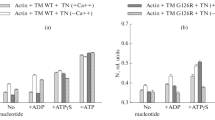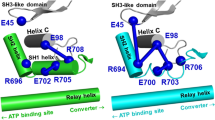Summary
The effects of various modifications of rabbit skeletal myosin subfragment 1 on thermal denaturation of subfragment 1 in ternary complexes with Mg-ADP and orthovanadate (Vi) or beryllium fluoride (BeFx) have been studied by differential scanning calorimetry. It has been shown that specific modifications of SH1 group of Cys-707 by different sulfhydryl reagents, trinitrophenylation of Lys-83, and reductive methylation of lysine residues promote the decomposition of the S1·ADP·Vi complex and change the character of structural transitions of the subfragment 1 molecule induced by the formation of this complex, but they have much less or no influence on subfragment 1 thermal stability in the S1·ADP·BeFx complex. Thus, the differential scanning calorimetric studies on modified subfragment 1 preparations reveal a significant difference between S1·ADP·Vi and S1·ADP·BeFx complexes. It is suggested that S1·ADP·Vi and S1·ADP·BeFx complexes represent structural analogues of different transition states of the ATPase cycle, namely the intermediate states S1**·ADP·Pi and S1*·ATP, respectively. It is also proposed that during formation of the S1·ADP·Vi complex the region containing both Cys-707 and Lys-83 plays an important role in the spread of conformational changes from the active site of subfragment 1 ATPase throughout the structure of the entire subfragment 1 molecule. In such a case, the effects of reductive methylation of lysine residues on the subfragment 1 structure in the S1·ADP·Vi complex are related to the modification of Lys-83.
Similar content being viewed by others
References
BAGSHAW, C. R. & TRENTHAM, D. R. (1974) The characterization of myosin-product complexes and of product release steps during the magnesium ion-dependent adenosine triphosphatase reaction. Biochem. J. 141, 331–49.
BARNETT, V. A. & THOMAS, D. D. (1987) Resolution of conformational states of spin-labeled myosin during steady-state ATP hydrolysis. Biochemistry 26, 314–23.
BIVIN, D. B., UE, K., KHOROSHEV, M. & MORALES, M. F. (1994) Effect of lysine methylation and other ATPase modulators on the active site of myosin subfragment 1. Proc. Natl Acad. Sci. USA 91, 8665–9.
BOBKOV, A. A. & LEVITSKY, D. I. (1995) Differential scanning calorimetric study of the complexes of myosin subfragment 1 with nucleoside diphosphates and vanadate or beryllium fluoride. Biochemistry 34, 9708–13.
BOBKOV, A. A., KHVOROV, N. V., GOLITSINA, N. L. & LEVITSKY, D. I. (1993) Calorimetric characterization of the stable complex of myosin subfragment 1 with ADP and beryllium fluoride. FEBS Letts 332, 64–6.
BOREJDO, J. & BURLACU, S. (1992) Velocity of movement of actin filaments in in vitro motility assay measured by fluorescence correlation spectroscopy. Biophys. J. 61, 1267–80.
BOTTS, J., THOMASON, J. F. & MORALES, M. F. (1989) On the origin and transmission of force in actomyosin subfragment 1. Proc. Natl Acad. Sci. USA 86, 2204–8.
BURKE, M. & REISLER, E. (1977) Effects of nucleotide binding on the proximity of the essential sulfhydryl groups of myosin. Chemical probing of movement of residues during conformational transitions. Biochemistry 16, 5559–63.
FISHER A. J., SMITH C. A., THODEN J., SMITH R., SUTOH K., HOLDEN H. M. & RAYMENT I. (1995) Structural studies of myosin: nucleotide complexes: a revised model for the molecular basis of muscle contraction. Biophys. J. 68, 19–28s.
GOODNO, C. C. (1979) Inhibition of myosin ATPase by vanadate ion. Proc. Natl Acad. Sci. USA 76, 2620–4.
GOODNO, C. C. (1982) Myosin active-site trapping with vanadate ion. Methods Enzymol. 85, 116–23.
GOODNO, C. C. & TAYLOR, E. W. (1982) Inhibition of actomyosin ATPase by vanadate. Proc. Natl Acad. Sci. USA 79, 21–5.
GOPAL, D. & BURKE, M. (1995) Formation of stable inhibitory complexes of myosin subfragment 1 using fluoroscandium anions. J. Biol. Chem. 270, 19282–6.
HENRY, G. D., MARUTA, S., IKEBE, M. & SYKES, B. D. (1993) Observation of multiple myosin subfragment 1-ADP-fluoroberyllate complexes by 19F NMR spectroscopy. Biochemistry 32, 10451–6.
HUSTON, E. E., GRAMMER, J. C. & YOUNT, R. G. (1988) Flexibility of the myosin heavy chain: direct evidence that the region containing SH1 and SH2 can move 10 Å under the influence of nucleotide binding. Biochemistry 27, 8945–52.
JOHNSON, K. A. & TAYLOR, E. W. (1978) Intermediate states of subfragment 1 and actosubfragment 1 ATPase: reevaluation of the mechanism. Biochemistry 17, 3432–42.
LEVITSKY, D. I., SHNYROV, V. L., KHVOROV, N. V., BUKATINA, A. E., VEDENKINA, N. S., PERMYAKOV, E. A., NIKOLAEVA, O. P. & POGLAZOV, B. F. (1992) Effects of nucleotide binding on thermal transitions and domain structure of myosin subfragment 1. Europ. J. Biochem. 209, 829–35.
LEVITSKY, D. I., GOLITSINA, N. L., BOBKOV, A. A., NIKOLAEVA, O. P., DEDOVA, I. V. & PAVLOV, D. A. (1995) A differential scanning calorimetric study of stable myosin-nucleotide complexes. Biophys. J. 68, 160a.
MARUTA, S., HENRY, G. D., SYKES, B. D. & IKEBE, M. (1993) Formation of the stable myosin-ADP-aluminum fluoride and myosin-ADP-beryllium fluoride complexes and their analysis using 19F NMR. J. Biol. Chem. 268, 7093–100.
MILLER, L., COPPEDGE, J. & REISLER, E. (1982) The reactive SH1 and SH2 cysteines in myosin subfragment 1 are cross-linked at similar rates with reagents of different length. Biochem. Biophys. Res. Commun. 106, 117–22.
MORNET, D., PANTEL, P., BERTRAND, R., AUDEMARD, E. & KASSAB, R. (1980) Localization of the reactive trinitrophenylated lysyl residue of myosin ATPase site in the NH2-terminal (27 K domain) of S1 heavy chain. FEBS Letts 117, 183–8.
MUHLRAD, A. (1983) Mechanism of adenosinetriphosphatase activity of trinitrophenylated myosin subfragment 1. Biochemistry 22, 3653–60.
MUHLRAD, A. & TAKASHI, R. (1981) Ionization of reactive lysyl residue of myosin subfragment 1. Biochemistry 20, 6749–54.
MULHERN, S. A. & EISENBERG, E. (1978) Interaction of spin-labeled and N-(Iodoacetylaminoethyl)-5-naphthylamine-1-sulfonic acid SH1-blocked heavy meromyosin and myosin with actin and adenosine triphosphate. Biochemistry 17, 4419–25.
PAVLOV, D. A., BOBKOV, A. A., NIKOLAEVA, O. P., MAGRETOVA, N. N., DEDOVA, I. V. & LEVITSKY, D. I. (1995) Thermal denaturation of myosin subfragment 1 modified at residue Lys-83 and its changes induced by nucleotide binding. Biochemistry (Moscow) 60, 835–42.
PANUSZ, T. H., GRACZYK, G., WILMANSKA, D. & SKARZINSKI, J. (1970) Analysis of orthophosphate-pyrophosphate mixtures resulting from weak pyrophosphatase activity. Anal. Biochem. 35, 494–504.
PHAN, B. C. & REISLER, E. (1992) Inhibition of myosin ATPase by beryllium fluoride. Biochemistry 31, 4787–93.
PHAN, B. C., FALLER, L. D. & REISLER, E. (1993) Kinetics and equilibrium analysis of the interactions of actomyosin subfragment-1·ADP with beryllium fluoride. Biochemistry 32, 7712–19.
PHAN, B. C., CHEUNG, P., MILLER, C. J., REISLER, E. & MUHLRAD, A. (1994) Extensively methylated myosin subfragment-1: examination of local structure, interactions with nucleotides and actin, and ligand-induced conformational changes. Biochemistry 33, 11286–95.
PHAN, B. C., CHEUNG, P. & REISLER, E. (1995) Phosphate analog probes of the nucleotide site on S1. Biophys. J. 68, 161a.
PONOMAREV, M. A., TIMOFEEV, V. P. & LEVITSKY, D. I. (1995) The difference between ADP-beryllium fluoride and ADP-aluminum fluoride complexes of the spin-labeled myosin subfragment 1. FEBS Letts 371, 261–3.
PRIVALOV, P. L. & POTEKHIN, S. A. (1986) Scanning microcalorimetry in studying temperature-induced changes in proteins. Methods Enzymol. 131, 4–51.
RAYMENT, I., RYPNIEWSKI, W. R., SCHMIDT-BASE, K., SMITH, R., TOMCHICK, D. R., BENNING, M. M., WINKELMANN, D. A., WESENBERG, G. & HOLDEN, H. M. (1993) Three-dimensional structure of myosin subfragment-1: a molecular motor. Science 261, 50–8.
REISLER, E. (1982) Sulfhydryl modification and labeling of myosin. Methods Enzymol. 85, 84–93.
REISLER, E., BURKE, M. & HARRINGTON, W. F. (1977) Reactivity of essential thiols of myosin. Chemical probes of the activated state. Biochemistry 16, 5187–91.
SLEEP, J. A., TRYBUS, K. M., JOHNSON, K. A. & TAYLOR, E. W. (1981) Kinetic studies on normal and modified heavy meromyosin and subfragment-1. J. Muscle Res. Cell Motil. 2, 373–99.
TAKASHI, R., DUKE, J., UE, K. & MORALES, M. F. (1976) Defining the ‘fast-reacting’ thiols of myosin by reaction with 1,5 IAEDANS. Arch. Biochem. Biophys. 175, 279–83.
TOYOSHIMA, Y. Y., KRON, S. J., MCNALLY, E. M., NIEBLING, K. R., TOYOSHIMA, C. & SPUDICH, J. A. (1987) Myosin subfragment-1 is sufficient to move actin filaments in vitro. Nature 328, 536–9.
WEEDS, A. G. & TAYLOR, R. S. (1975) Separation of subfragment-1 isoenzymes from rabbit skeletal muscle myosin. Nature 257, 54–7.
WELLS, J. A. & YOUNT, R. G. (1982) Chemical modification of myosin by active-site trapping of metal-nucleotides with thiol cross-linking reagents. Methods Enzymol. 85, 93–116.
WELLS, C. & BAGSHAW, C. R. (1984) The characterization of vanadate-trapped nucleotide complexes with spin-labelled myosins. J. Muscle Res. Cell Motil. 5, 97–112.
WERBER, M. M., PEYSER, Y. M., & MUHLRAD, A. (1992) Characterization of stable beryllium fluoride, aluminum fluoride, and vanadate containing myosin subfragment 1 — nucleotide complexes. Biochemistry 31, 7190–7.
WHITE, H. D. & RAYMENT, I. (1993) Kinetic characterization of reductively methylated myosin subfragment 1. Biochemistry 32, 9859–65.
Author information
Authors and Affiliations
Rights and permissions
About this article
Cite this article
Golitsina, N.L., Bobkov, A.A., Dedova, I.V. et al. Differential scanning calorimetric study of the complexes of modified myosin subfragment 1 with ADP and vanadate or beryllium fluoride. J Muscle Res Cell Motil 17, 475–485 (1996). https://doi.org/10.1007/BF00123363
Received:
Revised:
Accepted:
Issue Date:
DOI: https://doi.org/10.1007/BF00123363




